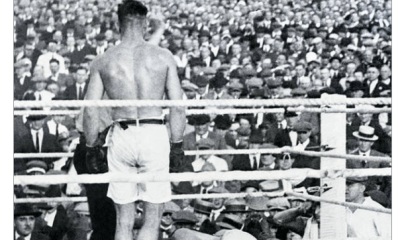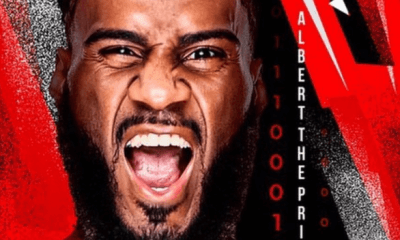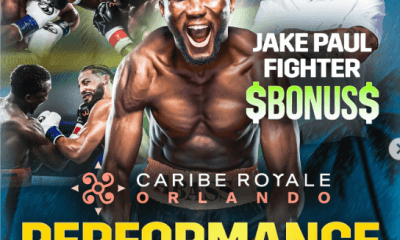Featured Articles
New Usyk Opponent Chazz Witherspoon Had a Good Story Spoiled by Harsh Reality
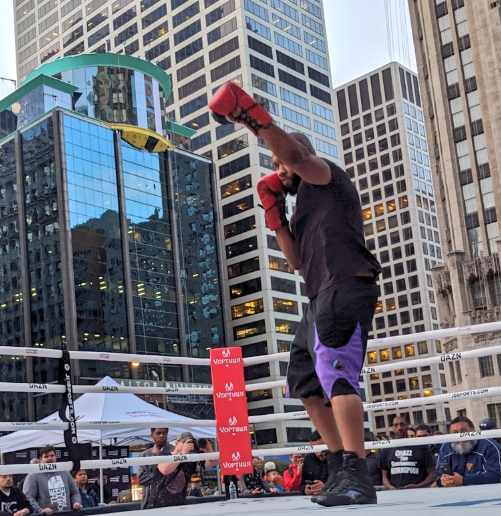
New Usyk Opponent Chazz Witherspoon Had a Good Story Spoiled by Harsh Reality
All other things being more or less equal, if pressed every writer or columnist would admit that their professional instinct is to pull for the story.
Once upon a time, heavyweight prospect Chazz Witherspoon had a very good and marketable story. He is the second cousin of two-time former alphabet heavyweight champion Tim Witherspoon and, in contradiction to all those wrong-side-of-the-tracks tales of boxers trying to rise above the impoverished circumstances of their upbringing, he was bright, polite and well-educated, so much so that the former star basketball player at Paulsboro, N.J., forsook the opportunity to walk on in that sport at Saint Joseph’s University in Philadelphia to concentrate on academics. His classroom performance at Paulsboro High earned him a full scholarship at St. Joe’s where he graduated with a bachelor’s degree in pharmaceutical marketing. Even his ring nickname, “The Gentleman,” set him apart from the trash-talking, profanity-spewing street guys who might have had genuine talent in the ring but sometimes got publicity for all the wrong reasons.
“Chazz Witherspoon was a good story,” admitted Teddy Atlas, the longtime ESPN boxing analyst who is now on Witherspoon’s old turf (Chazz was born in Philadelphia, as well as having gone to college there), where he is readying WBC light heavyweight champion Oleksandr Gvozdyk for his Oct. 18 unification matchup with IBF titlist Artur Beterbiev at the 2300 Arena in South Philly. “He was a nice kid, someone you root for. But that doesn’t mean every good story has a happy ending.”
It has been at least seven years since those who pay attention to the sport of boxing, and those who write about it, took much notice of the gentlemanly Chazz Witherspoon and his story. That, however, changed – at least temporarily – when he was named the replacement for a replacement as the opponent for former undisputed cruiserweight champion Oleksandr Usyk (16-0, 12 KOs), who makes his heavyweight debut against Witherspoon (38-3, 29 KOs) Saturday night at Chicago’s Wintrust Arena. The scheduled 12-rounder will be streamed by DAZN.
“I can’t wait to face Usyk,” said Witherspoon (pictured at yesterday’s open workout in Chicago). “I have been in training, ready for a big fight, and it doesn’t get any bigger than this.” Selected from a reported field of five fighters on standby in case of still another main-event adjustment, Witherspoon took the bout on four days’ notice after another designated victim, Tyrone Spong (14-0, 13 KOs), failed a test administered by the Voluntary Anti-Doping Association (VADA) and was scratched from his slot by the Illinois State Athletic Commission.
“Oleksandr is stepping up to heavyweight – and he’s going to find out it’s a totally different game. I’ve won my last eight fights, and I really feel that I’ve been waiting in the wings for a huge opportunity like this. I am going to put every ounce of myself into the fight on this massive stage.”
All well and good, and boxing doesn’t always follow the expected script, as demonstrated by such previous heavyweight longshot winners as Buster Douglas and Andy Ruiz Jr. Atlas expects Witherspoon, now 38 and likely facing his final opportunity to restore the career momentum blunted by past failures when stepping up in class, to dutifully play the same role assigned to Non-Power Five college football teams tasked with playing the Alabama Crimson Tide. Someone does periodically beat overwhelming odds to win the Powerball Lottery, right? But even Witherspoon has to realize that he was chosen for this dream shot not because he is the same reasonably hot prospect he once was, but because he is an aging trial horse with some residual name value and a story that can be milked of its last few drops of relevancy.
“He’s a competitive guy, so he’s going to go in there thinking he at least has a chance to win,” Atlas continued. “He’s a fighter, a real fighter, and real fighters always believe they can win. He wants to challenge himself, and I give him credit for that.
“But let’s be realistic. We live in the real world, not the world we wish it to be. This is Usyk’s first time putting his toe into the heavyweight pool. His handlers want him to make a big and impressive splash, and they want to be as certain as possible that they can control the result.
“This is not a learning experience for Usyk. They figure he’s learned enough. He’s undefeated, an Olympic gold medalist and the undisputed cruiserweight champion. This is not a Sherlock Holmes mystery that has to be solved. It’s pretty solvable. The butler didn’t do it. The proof is in the pudding. The pudding here is that three times Witherspoon stepped up and three times he lost convincingly.”
You want to compare odds? Douglas shocked Mike Tyson as a 42-to-1 underdog. Ruiz was a mere 11-1 outsider when he took down Joshua. At this time there are no odds posted regarding Witherspoon’s chances of upsetting Usyk, who, it should be noted, was 2018’s Fighter of the Year as selected by the Boxing Writers Association of America and The Sweet Science. If you want to surmise that “The Gentleman” is a 100-1 longshot, that might not be too much of a stretch. The plan always has been for Usyk, arguably the greatest cruiserweight of all time, to take just a few fights against Witherspoon-level opponents before testing himself against the heavyweight division’s major players, be it Deontay Wilder, Tyson Fury, Ruiz, Joshua or whomever else might fit that description a bit down the road.
Which is to say the Ukrainian southpaw would likely have been almost as overwhelming a choice to have won against his originally announced opponent, Carlos Takam (37-5-1, 28 KOs), or Spong, a former kickboxer whose pugilistic resume was crafted against a lineup of hand-picked opponents as soft as Spong’s six-pack abs are hard, which might owe in part to his now-verified use of clomiphene, a banned substance that can be used to increase testosterone. At least the 38-year-old Takam, at first glance, would appear to have posed a more legitimate test for Usyk than Spong or Witherspoon, in light of the fact that the veteran from Cameroon, now living in Las Vegas, lasted until the 10th round before being stopped by then-WBA/IBF champ Joshua on Oct. 28, 2017. His scheduled go at Usyk, originally scheduled for May 25, was scratched when Usyk suffered a torn bicep in training and had to withdraw.
Chazz Witherspoon might never have risen to the level of a Wilder, Fury or Joshua, or even that of cousin Tim, now 62, who has not been inducted into the International Boxing Hall of Fame and may never be, but who had quite a nice career in giving the great Larry Holmes one of his sternest tests in addition to having had separate and brief reigns as the WBC and WBA heavyweight titlist.
After a second-round knockout of Nigeria’s Innocent Otukwu on Sept. 16, 2006, that improved his record to 14-0 (8), Chazz was asked whether his “good family genes” were a contributing factor to his rising prominence.
“Oh, definitely,” he said. “You know you have it in your makeup when you got a champion’s blood running through your veins.”
Chazz remained a person of interest when he was paired against another young heavyweight with a hook of a story, Chris Arreola, whose stated goal was to become the first big man of Mexican heritage to win his sport’s most prestigious prize. When they squared off on June 23, 2008, a bout for the WBC Continental Americas belt that was televised by HBO, Witherspoon was 23-0 with 14 KOs and Arreola 23-0 with 21 wins inside the distance.
“Witherspoon and Arreola clearly are the two most advanced, relatively unknown American heavyweights,” veteran HBO analyst Larry Merchant opined before that bout. “The winner will emerge as the better of the two and immediately goes on the short list of U.S. contenders who could be in line to get a crack at one of the world titles in the relatively near future.”
Merchant’s words, as it turned out, were prophetic. Arreola – who, four bouts later challenged WBC champ Vitali Klitschko and would fight three times in all for heavyweight titles, losing each — had to settle for a third-round disqualification victory when Witherspoon’s corner team, having heard the bell, entered the ring while referee Randy Phillips was in the process of administering a count after Witherspoon had gone down a second time. Although Phillips’ decision to end the fight was a stunner, the outcome likely would have been the same; Witherspoon was wobbled in the first round and was decked twice in the third, lurching to his feet on shaky legs after the second knockdown.
There would be no title shots for Witherspoon, and an expected loss to Usyk likely would mean there never will be. In his two most important ring appearances after the Arreola disaster, ’Spoon was stopped in nine rounds by veteran contender Tony Thompson, then 38, on Dec. 5, 2009, and in three rounds by former Michigan State linebacker Seth Mitchell, a Golden Boy protégé, on April 28, 2012. Mitchell fought only three times after his stoppage of Witherspoon, sandwiching knockout losses at the hands of Johnathon Banks and, yes, Arreola, around a points nod over Banks, a onetime pupil of the late Emanuel Steward now best known as the trainer of Gennadiy Golovkin.
While it is true that Witherspoon has strung together an eight-fight winning streak, those outings were spread over five years and against suspect opposition. Raise your hand if you are familiar with the careers of the men defeated during that run by Witherspoon, a list that includes the non-celebrated likes of Tyyab Beale, Cory Phelps, Galen Brown, Nick Guivas, Michael Marrone, Carlos Sandoval, Lamont Capers and Santander Silgado.
Which is not to say that Witherspoon will not at least remind some people of the promise of better things that marked his emergence as a fighter to be tracked. If all the stars align just so, he could come away as a sort of Otto Wallin, who gave such a good, and surprising, account of himself in his recent points loss to Tyson Fury. Avoiding humiliation against a clearly superior fighter like Usyk in a high-visibility scrap might provide enough incentive for him to keep on keeping on. Even being on the wrong side of a rout might not be all bad.
“At least there should be some fairness in this because he’s going to get a decent payday,” Atlas, ever the pragmatist, noted. “I’m sure he’s getting paid pretty well because he had the promoter (Eddie Hearn) over a barrel at the 11th hour. I just hope he doesn’t get hurt too bad.”
Check out more boxing news on video at The Boxing Channel
To comment on this story in The Fight Forum CLICK HERE
-

 Featured Articles4 weeks ago
Featured Articles4 weeks agoThe Hauser Report: Cinematic and Literary Notes
-

 Featured Articles4 weeks ago
Featured Articles4 weeks agoOscar Duarte and Regis Prograis Prevail on an Action-Packed Fight Card in Chicago
-

 Book Review3 weeks ago
Book Review3 weeks agoMark Kriegel’s New Book About Mike Tyson is a Must-Read
-

 Featured Articles2 weeks ago
Featured Articles2 weeks agoThe Hauser Report: Debunking Two Myths and Other Notes
-

 Featured Articles2 weeks ago
Featured Articles2 weeks agoMoses Itauma Continues his Rapid Rise; Steamrolls Dillian Whyte in Riyadh
-

 Featured Articles4 weeks ago
Featured Articles4 weeks agoRahaman Ali (1943-2025)
-

 Featured Articles4 weeks ago
Featured Articles4 weeks agoTop Rank Boxing is in Limbo, but that Hasn’t Benched Robert Garcia’s Up-and-Comers
-
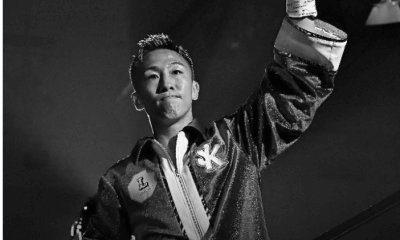
 Featured Articles3 weeks ago
Featured Articles3 weeks agoKotari and Urakawa – Two Fatalities on the Same Card in Japan: Boxing’s Darkest Day


